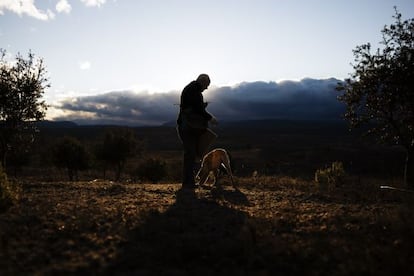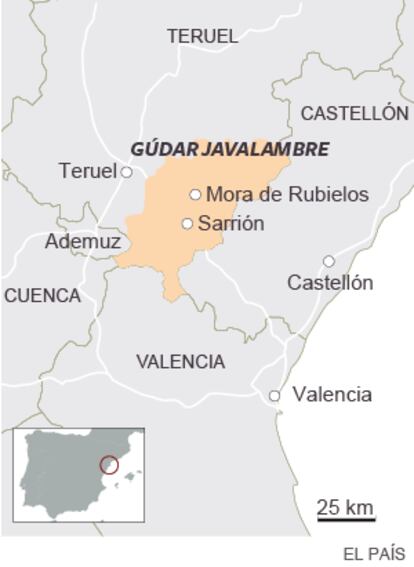The truffle capital of the world
A remote corner of eastern Spain has become the largest global producer of the delicacy


Gúdar Javalambre is a small district of around 8,600 inhabitants who live in 24 villages spread out across the harsh landscape of the Maestrazgo mountains that lie between Valencia and Teruel in eastern Spain. The area, whose population has fallen steadily over the last half-century, is one of the least-populated in Europe – but that is not what marks it out. What does it make it remarkable, however, is the fact that Gúdar Javalambre is now the center of a global truffle industry that over the last decade has breathed new life into the district, creating jobs and reviving the local economy.
Spain’s black truffle harvest in 2013 and 2014 – the mushroom is collected between December and March – totaled 40 tons, of which 36 came from Gúdar Javalambre. Over the same period, France produced between 40 and 50 tons.
“The truffle has created sustainability in areas that were dying. Until the truffle came along, times were tough,” says María Jesús Agustín, the 47-year-old owner of Manjares de la Tierra, which she set up a decade ago with two other women to market truffles. She says that were it not for the mushrooms, she would have left long ago.
The truffle has helped to keep people from moving away, and it’s become a motor of the economy” Juan María Estrada, founder of Inotruf
“The rural world is being lost,” says her partner, Merche Marco. “If there’s work, then it’s more likely that people will stay.” The company, like many others in the area, has been given a boost by the internet, and as well as in its small store in Sarrión, the largest village in the district, with 1,000 inhabitants, it now sells its wares worldwide via the web.
Like most of its neighboring communities, there’s little going on in Sarrión on a chilly February morning. There are few shops, and most of the houses seem empty or used only at weekends or for vacations. The population density here is among the lowest in the European Union: 3.4 people per square kilometer, similar to that of northern Scandinavia – the EU average is 116 kilometers per square kilometer. The land is hard and yields little. A few ruined farms dot the landscape.
But there are signs of improvement out in the countryside. Entire fields have been planted with holm oaks, the species of tree that provides the best support for truffles. “There is more truffle cultivation here than any single place else on earth,” says Juan María Estrada, who moved to the area from his native Catalonia to set up Inotruf with a partner. “There aren’t many farming options here, the land is poor,” says Estrada. “The truffle has helped to keep people from moving away, and it’s become a motor of the economy.”

Given the lack of Spanish companies able to process truffles, around 90 percent of output here is exported to France, meaning that many truffles sold as French actually originate in Teruel. The variety grown here is the melanosporum, also known as the Perigord truffle. The price is set locally at a market held every Saturday evening. This week the price was between €450 and €600 a kilo – it varies depending on the quality and output. A reasonable-sized truffle costs around €20 (four grams is enough to make a meal).
The Doñate brothers are one of the region’s truffle success stories. The four have been involved in the business for the last four decades, learning their skills by hunting the prized mushroom with their father, and using specially trained dogs, without which it is not possible to find mature specimens. Until the late 1980s, truffles were collected in this way, and as now, were mainly exported. Historically, the mushroom has never been part of Spanish cuisine, perhaps because truffles were banned by the Inquisition.
In 1987, a recently graduated agronomy student named Francisco Edo Navarrete, who had written a thesis on truffle cultivation, organized a course to teach local farmers about growing the mushroom. His initiative changed everything: his first intake set up their own truffle farms, and the business potential soon became clear, even though holm oaks can take up to a decade to yield their fruits.
“People who were considering leaving decided to stay because they started to find work,” says Ángel Doñate. His older brother, Manuel, aged 61, says he was set to leave the community, but instead decided to try his hand at the practice he had learned as a child. Something as ancient and as deep rooted as the symbiotic relationship between a tree and a mushroom, between men and dogs, coupled with the idea of living off the land, has sparked an economic boom.
Now the growers of Gúdar Javalambre say they want to move to the next stage, which is to begin adding value to their product by processing it themselves. “Truffles have given us hope that we can make a future for ourselves here,” says Miguel Pérez, the 51-year-old owner of the Trufa Negra hotel in Mora de Rubielos, as well as the Melanosporum restaurant, whose menu is pretty much dedicated to the truffle. He also owns a company that used to be used for public works projects, but now prepares fields for truffle cultivation. His daughter Sandra runs the hotel and manages Trusens, a truffle product line. She belongs to the generation that stayed. “Just about every sector of the local economy is focused on the truffle in one way or another,” she says. In December, a truffle trade fair was held in Sarrión that attracted 22,000 people.
Atruter, the association that represents the area’s truffle growers, now has 500 members, a huge number for such a small community. “We like to say that we’re the world truffle capital, although there isn’t the same business culture as in the Perigord, in France,” says Julio Perales Vicente, Atruer’s president. “We need to take the next step by setting up companies to process truffles and to start finding markets in Spain.”
Overexploitation and drought have largely done away with wild truffles, but it is now possible to artificially nurture mycorrhizae, or fungus roots, that will later produce truffles. At present, around 6,500 hectares are under truffle cultivation, and more land is due to be put to use. The most expensive part of the process is installing irrigation systems, says Ángel Doñate, admitting that he and his fellow growers are still working on a trial-and-error basis, and that the truffle is an unpredictable crop. “You can have a difficult year, and suddenly all your planning is worth nothing, and you have to find solutions to new problems,” he adds.
Rafael, his brother, sums up the challenge: “With truffles, two and two is never four. That’s why they’re so valuable.”
Tu suscripción se está usando en otro dispositivo
¿Quieres añadir otro usuario a tu suscripción?
Si continúas leyendo en este dispositivo, no se podrá leer en el otro.
FlechaTu suscripción se está usando en otro dispositivo y solo puedes acceder a EL PAÍS desde un dispositivo a la vez.
Si quieres compartir tu cuenta, cambia tu suscripción a la modalidad Premium, así podrás añadir otro usuario. Cada uno accederá con su propia cuenta de email, lo que os permitirá personalizar vuestra experiencia en EL PAÍS.
En el caso de no saber quién está usando tu cuenta, te recomendamos cambiar tu contraseña aquí.
Si decides continuar compartiendo tu cuenta, este mensaje se mostrará en tu dispositivo y en el de la otra persona que está usando tu cuenta de forma indefinida, afectando a tu experiencia de lectura. Puedes consultar aquí los términos y condiciones de la suscripción digital.







































